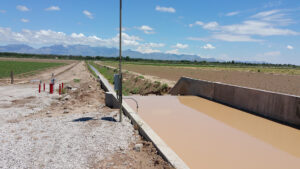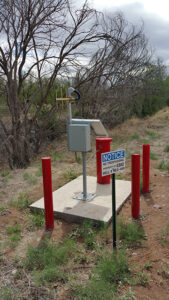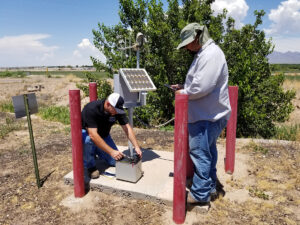New Mexico’s Elephant Butte Irrigation District (EBID) benefits not only from the scientific expertise of its staff, but also from a sophisticated network of remote telemetry units (RTU) and supervisory control and data acquisition (SCADA)–equipped meters. The information from these devices helps EBID capture stormwater and manage groundwater pumping, supplementing its drought-affected surface water supplies.
In this interview, Patrick Lopez, EBID’s SCADA Systems director, speaks with Irrigation Leader Managing Editor Joshua Dill about the district’s hydrology and how new technology is helping EBID manage its water resources.
Joshua Dill: Please tell us about your background and how you came to be in your current position.
Patrick Lopez: I have worked at EBID for 17 years, all of which I have spent in the SCADA Systems Department. I am a graduate of New Mexico State University and started off as EBID’s first RTU technician back in 2002. In 2005, I was promoted to SCADA supervisor and spent 9 years in that position before becoming the hydrology director and IT director for 5 years. Last year, we changed the department structure and my department was renamed SCADA Systems.

Joshua Dill: For those who might not know a lot about the district, would you give a basic overview of EBID?
Patrick Lopez: Our district boundaries run from Caballo Dam, which is situated between Caballo and Arrey, New Mexico, all the way down to the El Paso, Texas, area, spanning a distance of 90 miles. We serve approximately 90,000 acres, which are split into three distinct diversion areas located in Arrey; Leasburg, New Mexico; and Mesilla, New Mexico. We are part of the Rio Grande Project, a Bureau of Reclamation project, along with El Paso County Water Improvement District No. 1 and Mexico.
Joshua Dill: What is distinctive about the hydrology of your area?
Patrick Lopez: Our surface water originates from snowpack in southern Colorado and northern New Mexico. We are dependent on good snowpack in order to deliver our full surface water allotment to our farmers. When snowpack levels are below average, we’ve had to deliver a significantly reduced water allotment to farmers, although their ability
to pump groundwater helps offset these shortages. For the last several years, we haven’t been getting the snow we’re used to, so our surface water allotment has been dwindling. RTU monitoring has become crucial for maximizing the amount of water we do have, ensuring we are highly efficient with our water. Prolonged drought conditions have also led people to find new alternative water sources for irrigation purposes and to preserve aquifer health.

Stormwater has become an important alternative to compensate for shortages. Storm inflows to the Rio Grande can in no way compensate for the reduced surface water allotment, but they are a free water source. Over the last 4 years, we’ve done a good job of capturing stormwater by first monitoring potential inflow with a network of RTU-monitored watershed weather stations, rain gauges, and arroyo channels. We divert this water into our canal system and use it for irrigation, we use our drain system to allow it to seep back into the ground.
We’re currently working on a WaterSMART grant with the Bureau of Reclamation that will allow us to expand our storm monitoring by installing 16 additional rain gauges, improving arroyo channel monitoring, automating stormwater capture turnout sites, and constructing a new Rio Grande metering cable site. We will also be working with the New Mexico Water Resources Research Institute to develop modeling and management tools to assist with drought mitigation.
Joshua Dill: What kind of data are you collecting with your SCADA systems, and how is it used?
Patrick Lopez: Our department monitors the initial release from Caballo Dam and several Rio Grande gauging stations. We also monitor our diversion points, canal headings, lateral headings, lateral spillways, and drain system. As I mentioned previously, we also track storm activity and stormwater inflow through weather stations, rain gauges, and arroyo channel sites.
In addition to our surface water monitoring, we also monitor groundwater wells and farmer irrigation wells. When I began working at EBID, we had approximately 50 RTU sites; that number has now grown to just under 500. In addition to our SCADA system, our department also conducts regular water quality field sampling and also tests for E. coli levels.
The data we collect is not only used by our personnel; it is also used by outside agencies including Bureau of Reclamation, the U.S. Geological Survey, the Interstate Stream Commission, and the New Mexico Office of the State Engineer. The data is primarily used by our management team and employees to maintain and operate our system. We also use our data for groundwater modeling and use several years of data to identify and predict trends in our system.
Joshua Dill: How has that information changed EBID’s operations over the past few years?
Patrick Lopez: It has improved our efficiency by allowing our personnel to view near-real-time data. Prior to RTU monitoring, periodic meter notes and paper water level charts were used, which basically gave us snapshot views of what was occurring. Any issue that arose with the chart could not be caught and addressed until the next field visit. RTU monitoring has allowed us to see trends or variations in the water, enabling personnel to adjust or react immediately. It provides a window into what’s occurring in the field that you can check at any time.

Joshua Dill: Please tell us about EBID’s gravity meter device and what it is used for.
Patrick Lopez: We purchased a Burris Gravity Meter, made by the ZLS Corporation, earlier this year. We are currently training with the meter and learning the calibration procedures. I anticipate that we will conduct our first full- scale site visit in mid-August. We will be visiting a total of 66 sites that span the entirety of our district.
It is difficult to quantify the volume of water in our aquifer, but this device will allow us to closely calculate the additional volume of water created once our surface water release is in our river and canal system. We will also look into calculating the volume displaced in the aquifer once our irrigation season has finished.
Another area we are interested in applying gravity meter readings to is stormwater capture and aquifer replenishment. With our current RTU monitoring, we can quantify the amount of stormwater captured through our structures and see its immediate and prolonged effects on nearby groundwater levels. These readings may also allow EBID
to measure the total volume change in the immediate area where capture has occurred and also measure the total area impacted. We will conduct site readings when we are alerted about incoming stormwater and then do a follow-up reading after capture has occurred. My hope is that, working with my colleague Dr. Erek Fuchs, EBID’s groundwater resources manager, we can establish a correlation between, say, the number of acre-feet of water we capture at a site and the rise in the groundwater at the aquifer level over a specific area.
Joshua Dill: What is the device like? Is it hand held?
Patrick Lopez: It’s about 1 foot wide, 1 foot tall, and 8 inches deep. It is a hand-held device. It uses a spring or coil inside that is able to measure gravity. The device is delicate—any type of jolt can damage or severely compromise the internal components.
Joshua Dill: What trends do you see in the hydrology of your region?
Patrick Lopez: Drought is obviously the biggest trend. Below-average snowpack and a general lack of precipitation have led to shortages in surface water allotment. Groundwater pumping has increased over this time to help compensate. I see the need to fallow certain fields. Finally, many farmers have moved to pecan crops.
Patrick Lopez is the SCADA Systems director at Elephant Butte Irrigation District. He can be contacted at patlopez@ebid-nm.org.
